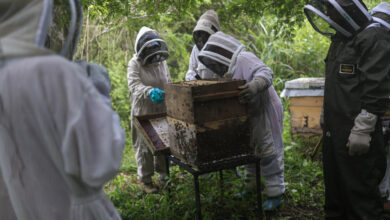5 Unmissable Destinations in Colombia
Colombia is a magical place where you can find from the coldest but charming places to the jungle and the hot Caribbean.
Colombia is a magical place where you can find from the coldest but charming places to the jungle and the hot Caribbean.

The Woman Post | Carolina Rodríguez Monclou
Listen to this article
It is also a place of innovating friendly and happy people. The following cities were chosen by one of the travel industry's most prestigious awards, the World Travel Awards. Colombia was nominated in 10 categories for being one of the best destinations in the world to travel.
1. San Andrés
San Andrés is a Caribbean island, unlike any other. It's also the best-kept secret of Colombia. This place has beautiful beaches and invites you to snorkel. Around the island is a 30km long road that can be explored with a tourist bus. A must stop is Morgan's Cave with a pirate theme park. In the south of the island is a tourist attraction, the Hoyo Soplador, through a small tunnel in the coastal rocks air is pressed through by the waves. Across the city beach of San Andrés is the little palm island called Johnny Cay. The island is quickly reached by boat. This paradise has a beautiful beach and a surprisingly large number of lizard species.
2. Bogotá
Bogotá is located in the center of Colombia, on the high plateau, making it the third-highest capital in South America. The city's historical district is called La Candelaria, which is home to many museums, colonial buildings, some cool graffiti, and the famous Teatro Colón. You can also find the main square of the capital called Plaza Bolívar, where the Palace of Justice, the Primary Cathedral, the National Capitol, home of the Congress of Colombia, and Bogotá's city hall, the Lievano Palace, are located. Another cool thing to do in Bogotá is to head up the Cerro Monserrate. This is where you can enjoy the best view of the city.
Also read: SAFETY TIPS IF YOU ARE THINKING OF TRAVELING ALONE
3. Medellín
Medellín is the second-largest city in Colombia. With its many hotels, hostels, restaurants, bars, and clubs, El Poblado is the most popular neighborhood for travelers. It's colorful, touristy, and very safe. An excellent spot to base yourself. One of the reasons why Medellín is such an attractive city are the many parks you can find here. Little escapes from the bustling city. One of the most beautiful is The Botanical Gardens, which are located right next to the University meter station. Because the city is located on many hills, you can also take the cable car. This way, you can also access the vast Arví Park, a nature reserve which is the largest of its kind in the country.
4. Cartagena
Cartagena is a port city founded in 1533. In 1984, Cartagena's colonial world city and fortress were designated a UNESCO World Heritage site. One of the favorites places to visit is Castillo San Felipe. Another cool thing to do in Cartagena is to walk the Old City wall, which is incredibly cool to walk in the afternoon when you have the best light to take some fantastic photographs. 11km of defensive walls surrounds the historic center of the city. You can also go to Isla Grande, the secret paradise of Colombia.
5. Cali
Cali is the most popular city in southwest Colombia. As Cali is the capital of salsa music, there is a monument dedicated to one of its most famous musicians: Jairo Varela, the founder of Grupo Niche. Another thing to do if you want to check out Cali's city center is to walk along the river. You start at the La Ermita church. Then you walk along the river in the park until you get to the area of San Antonio, where you can find all the restaurants, spas, cafes, and a lot of street art. You can go to La Topa Tolondra, one of the most famous salsa bars in the city.
There's no doubt of Colombia's infinite beauty and magic. Each city is an experience full of adventures, delicious food, big laughs, and opportunities. If you want to have fun and get the best views in the world, Colombia must be on your travel list.




